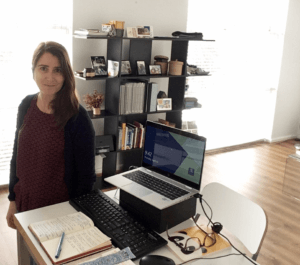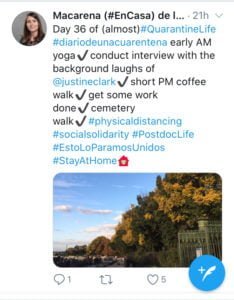Spanish architect and postdoctoral research fellow Macarena de la Vega shares the challenges of lockdown and working from home in a new city.

I moved to Melbourne almost three months ago to continue my career as a young postdoctoral researcher. Just over two months ago I moved into what is now Home, and one more month after that, I requested permission to Work from Home. I was feeling anxious about the amount of people in the building in which I worked. Now, I really look forward to the day when campus restrictions are eased, and we are allowed to go back to the office, which is literally just a 10-minute walk away from Home.
What is your work-from-home space like?
Home is a light-filled one-bedroom apartment, which I was really lucky to find given how many studios are advertised as one-bedrooms. My Ikea bench-height not-too-stable breakfast table is now my work station, and I sit on a high stool. Not ideal and definitely against Work Health and Safety regulations. One advantage is that it is quite easy to transform it into a standing workstation. The trick: I place a T2 box one way, so my eyes are aligned with the laptop screen while sitting down; placed the other way, it raises the screen enough to align with my eyes while standing up. It took some trial and error with different boxes to find the appropriate one. Other advantages: it is quiet, unless I play some music, and the views from my two ceiling-to-floor windows is really nice. I see a bit of the city in the background (unless it is raining heavily), the plants and flowers outside my building and an old brick house across the street.

What work do you do here?
It has been over a month since I started trying to Work from Home, and there has been more Home than Work. I probably should not be writing this for Parlour, given that my ultimate boss is one of its directors and founders. But I think she will understand, as she has been very supportive of staff throughout the Covid-19 situation, as have been my direct supervisors. I even have a relatively easy task I could be doing without needing to think much. As part of my current research project, I have conducted a series of interviews with preeminent architectural historians in/of Australia and New Zealand. Now, I have many hours of interviews to listen to in order to correct pages of transcripts. I guess I am lucky: no distractions, no one to “bother” me or take care of other than myself, and I have a mechanical task that could fill my Work hours. I have no excuse. However, this has probably been my least productive month ever.
Did you work from home pre-COVID-19? If so, how has the experience of remote working changed for you in the last few weeks?
My experiences of Work from Home do not necessarily come as a surprise. I have always been this bad at making Work from Home work. I did most of the work for my bachelors’ final design project from the library of my architecture school in Madrid. I wrote my master’s dissertation from the ‘researchers’ room’ in that same library and, subsequently, wrote my PhD dissertation between HDR offices and libraries, never at home. As a result, in my case, I cannot think of any benefit to working from home other than keeping safe and cooking instead of reheating lunch. After more than one month, I am still trying to find the tools and strategies to make this work. What I guess I can share is the tools and strategies I am using to not let this situation, and my resulting unproductivity, overwhelm and depress me; itself a challenge.
What have been the biggest challenges so far?
Just as I knew there was going to be more Home than Work, I was aware that this situation was a threat to my mental health. Readers that have family members and loved ones scattered around the world these days understand how hard it is to keep track of the pandemic in different countries. In this regard, I hit the jackpot: most of my family and friends are in Spain, but my brother lives in Sheffield (UK) and my sister with her young family (including my beautiful one-year old goddaughter) in Cleveland (US); three of the most affected countries so far. This means that for all of us to be awake and chat, it needs to happen around 6am or 11pm my time. On the bright side, my partner lives in New Zealand, and at least I do not have to worry much on that front since they are crushing the curve. However, this is not necessarily what we had in mind when our relationship became long distance. I was really looking forward to spending the Easter break exploring around Wellington with him. In my case, I juggle preoccupations and responsibilities that are outside of Home and the black cloud over my head, which reminds me of what I should be doing: Work.
What strategies are you using to lift your spirits and maintain mental wellbeing?
I know the self-care theory, and I hope readers do too: exercise, try not to feel guilty and be kind to yourself, ‘chunk’ your tasks into small pieces of writing and get going, as motivation will follow as a result, etc. I learned/needed these strategies while working on my PhD, and I did not have to Work from Home then. For four weeks, I have started (most of) my days with 30 minutes of yoga and finish them with a long walk around my new neighbourhood. Yoga is another thing that until now I had not been able to practise at Home. I always found it easier to do it in a group, but at least that is happening. However, this structure stopped working for me and I hit a ‘bump’ around the Easter break. This week I realised that I need to do a bit more exercise in the morning, I need the fresh air and extra endorphins, so I have started going for 30-minute allegedly ‘power’ walks before I sit on my high table to try to do some Work. So far, it seems to be helping. But I have learned that I need to be more flexible and adapt my daily routines so that they are helpful on any particular day, instead of becoming a rigid framework that does more harm than good. Lately, I have been connecting with my new office mates over zoom for some Shut Up and Write sessions and coffee breaks, and it also helps “recreate”, even if it is virtually, the office environment and its social interactions.

Have you discovered any tools (technological or otherwise) that have been particularly useful for remote working?
The most useful strategy for me, both before and during the pandemic, is to share challenges and goals with my support network and have them hold me accountable (within reason these days). In my case, I can count on an amazing group of friends, all brilliant female academics and researchers based in Brisbane, who both support and hold me accountable. For some time, I have also been sharing my experience as a PhD student first, and as a young researcher now, on Twitter. In my opinion, it is a fantastic platform in which to find support, collegiality, tips and guidance from very generous people from very different disciplines/backgrounds. Since writing a diary now may be a bit of a stretch for me, at least I am sharing almost daily updates on achievements (even if only on the cooking front) and challenges.
There is still more Home than Work for me these days. I have the feeling that it is the result of the amount of effort and energy that goes into maintaining my health and wellbeing while at Home. When/if that becomes easier, hopefully there will be more Work.
Macarena de la Vega is a Spanish architect with a PhD in Architectural History. She is a Postdoctoral Research Fellow at the University of Melbourne’s Australian Centre for Architectural History, Urban and Cultural Heritage (ACAHUCH), working on the research project ‘The Mental Life of the Architectural Historian of Australia and New Zealand’. Her field of interest is the study of the writing of architectural history, its historiography, with a focus on the recent past and the ‘global’. She serves as Social Media Manager and committee member of the Society of Architectural Historians, Australia and New Zealand (SAHANZ).





















